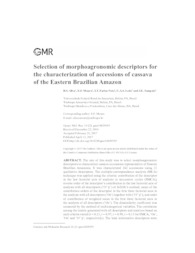Selection of morphoagronomic descriptors for the characterization of accessions of cassava of the Eastern Brazilian Amazon.
Selection of morphoagronomic descriptors for the characterization of accessions of cassava of the Eastern Brazilian Amazon.
Author(s): SILVA, R. S.; CUNHA, E. F. M.; FARIAS NETO, J. T. de; LEDO, C. A. da S.; SAMPAIO, J. E. de
Publication year: 2017
Types of publication: Journal article
Unit: Embrapa Eastern Amazon
Keywords: Descritores, Mandioca, Manihot Esculenta
Observation
Some of Embrapa's publications are published as ePub files. To read them, use or download one of the following free software options to your computer or mobile device. Android: Google Play Books; IOS: iBooks; Windows and Linux: Calibre.
Access other publications
Access the Agricultural Research Database (BDPA) to consult Embrapa's full library collection and records.
Visit Embrapa Bookstore to purchase books and other publications sold by Embrapa.

